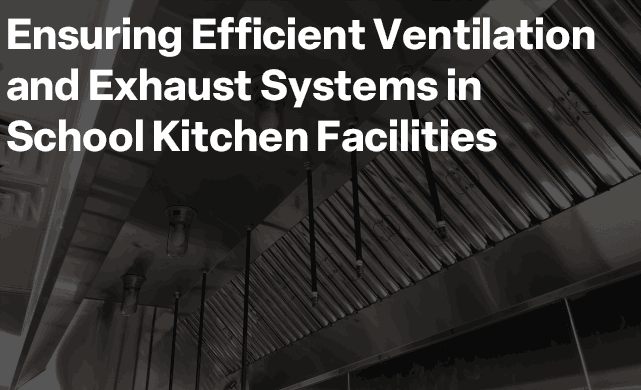Proper ventilation and exhaust systems are crucial for maintaining a safe and healthy environment in school kitchen facilities. Efficient ventilation helps remove airborne pollutants, excess heat, and unpleasant odors, ensuring a comfortable and productive space for staff and students. In this blog, we will discuss practical tips to ensure efficient ventilation and exhaust systems in school kitchen facilities.
Assess the existing ventilation system: Begin by assessing the current ventilation system in your school kitchen. Check if it complies with local building codes and regulations. Determine whether the system adequately removes cooking fumes, steam, and other contaminants. Consider consulting with a professional HVAC technician to conduct a thorough evaluation.
Proper hood selection: Selecting the right hood for your kitchen is essential. Hoods come in various types, such as canopy hoods, island hoods, and wall-mounted hoods. The size of the hood should match the size of the cooking equipment and the amount of heat and fumes generated. Ensure that the hood is installed at an appropriate height to effectively capture and remove pollutants.
Optimal hood placement: The placement of the hood plays a vital role in its efficiency. Install the hood as close to the cooking equipment as possible to capture fumes effectively. Consider the type of equipment, its location, and the layout of the kitchen when determining the optimal hood placement.
Adequate exhaust fan capacity: The exhaust fan is responsible for pulling the contaminated air out of the kitchen. Ensure that the fan has sufficient capacity to handle the cooking load. A fan with inadequate capacity will not effectively remove fumes and can lead to poor ventilation. Consult with an HVAC professional to determine the appropriate fan size for your kitchen.
Regular maintenance: Regular maintenance is essential to keep the ventilation and exhaust systems operating efficiently. Clean the hood, filters, and ductwork regularly to remove grease buildup and prevent clogs. Inspect the exhaust fan, motor, and belts for proper functioning and replace any worn-out components promptly. Consider establishing a maintenance schedule to ensure these tasks are performed regularly.
Balancing air intake and exhaust: Proper airflow balance is crucial for an efficient ventilation system. Ensure that there is a balanced combination of air intake and exhaust to prevent negative pressure or inadequate ventilation. A professional HVAC technician can help you assess and adjust the air balance as needed.
Consider energy-efficient options: Opt for energy-efficient ventilation and exhaust systems to reduce energy consumption and operating costs. Look for systems with variable speed controls that adjust the fan speed based on cooking demand, saving energy when the load is low. Additionally, consider installing heat recovery systems that can capture waste heat and use it to preheat incoming air, further improving energy efficiency.


















